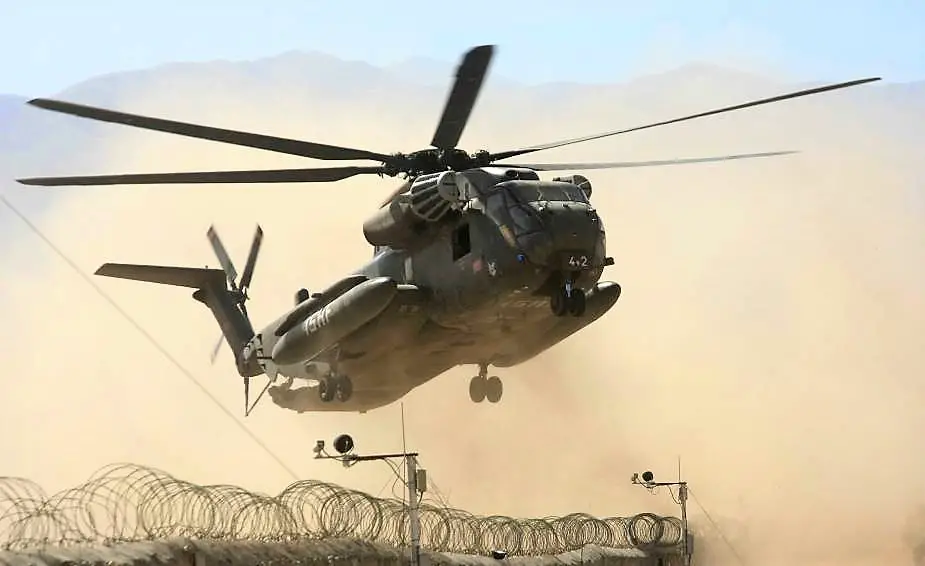Breaking news
Elbit Systems to supply more EW self-protection systems for CH-53 Sea Stallion helicopters of German Air Force.
Elbit Systems announced on June 14 that it was awarded an additional contract by Airbus Helicopters for the Federal Office for Bundeswehr Equipment, Information Technology and In-Service Support, for the provision of Airborne Electronic Warfare (EW) self-protection systems for the Sikorsky CH-53 GS/GE Sea Stallion transport helicopters, as part of the platform upgrade program led by Airbus Helicopters.
Follow Air Recognition on Google News at this link
 Sikorsky CH-53G Sea Stallion of the German army in Afghanistan (Picture source: Bundeswehr/Dana Kazda)
Sikorsky CH-53G Sea Stallion of the German army in Afghanistan (Picture source: Bundeswehr/Dana Kazda)
Under the contract, Elbit Systems, supported by Elbit Systems Deutschland, will provide digital Radar Warning Receivers (RWR), EW Controllers (EWC) and Counter Measure Dispensing Systems (CMDS). The digital RWR and EWC rapidly detect and accurately locate a wide range of threats, even in a dense EW environment, enabling reliable and timely warning and effective protection. The systems feature complete and independent threat programmability, enabling the seamless update of emitter libraries as well as flight data recording for pilot debriefing and training. Coupled with the CMDS the entire system provides the German Air Force with a high level of operational effectiveness.
Oren Sabag, General Manager, Elbit Systems ISTAR and EW: "We are proud to cooperate with Airbus Helicopters and appreciate the trust that the German Air Force places in our leading technologies that will continue to provide enhanced survivability and to increase mission effectiveness."
In 1966, the German army evaluated both the CH-53 and CH-47 Chinook as a replacement for the H-21 and H-34G helicopters with an initial requirement for 133. The purchase of the CH-53 was approved in June 1968 but due to budget constraints, only 110 were ordered. Following the delivery in 1969 of two pre-production helicopters from Sikorsky, the production aircraft were license-built by VFW-Fokker at Speyer in Germany. The first German-built CH-53G Mittlerer Transporthubschrauber helicopter flew from Speyer on 11 October 1971 and was delivered to the Erprobungsstelle der Bundeswehr 61 flight test center at Manching on 1 December 1971.
The German Army Aviation Corps received 110 type CH-53Gs, derivatives of the CH-53D, between 1971 and 1975. 108 helicopters were built in Germany by VFW-Fokker. The first flight by a German CH-53G was made in 1971, followed in March 1973 by the delivery of the first machines to Heeresfliegerregiment (HFlgRgt, Army Aviation Corps Regiment) 35 in Mendig, and shortly afterward to the newly formed Army Aviation Corps Regiment 15 based at Rheine and Army Aviation Corps Regiment 25 based at Laupheim.
In order to meet ever more demanding specifications, over time the CH-53G received modifications from 1990 designed to improve its service life and operational capabilities. These involved three major upgrades: new missile warning and self-protection systems; provision for two external fuel tanks allowing the range to be increased to 1,100 mi (1,800 km) when carrying 36 armed soldiers or a 12,100 lb (5,500 kg) payload; and addition of a night vision goggles-compatible cockpit for night low-level flying capabilities. All CH-53Gs were upgraded by Eurocopter Germany by early 2001, resulting in updated GS/GE/GA variants.
As a result of foreign military operations, 20 CH-53G helicopters were converted to perform Combat Search and Rescue (CSAR) missions. Version CH-53GS is equipped with modernized IFR equipment, additional exterior fuel tanks, low-flight night vision cockpit and NVG, partial ballistic protection, engine dust collectors, missile countermeasures and self-defense armament. Additionally, the original engines were replaced by the more powerful T64-100 engines.
German Army Aviation Corps units have carried out a wide range of international missions under the auspices of NATO and the UN, providing transport for members of UNSCOM in Iraq, serving in Kosovo with KFOR, with IFOR in Bosnia and Herzegovina, and more recently with ISAF in Afghanistan. On 1 January 2013, all Army Aviation Corps CH-53Gs were transferred to the German Air Force and incorporated into Helicopter Wing 64.
During the 2010s, Germany was reportedly considering options for replacing its aging CH-53G fleet, with candidates including the Chinook and the CH-53K model. On 29 September 2020, the German Ministry of Defense cancelled the "Schwerer Transporthubschrauber" (STH) heavy-lifting helicopter program for 45 to 60 helicopters after the initiative was judged to be too expensive and stated that its CH-53Gs fleet would be replaced following a period of reexamination. In 2022, the Federal Government announced that all of Germany's CH-53s would be replaced by 60 CH-47F Chinooks.
 Sikorsky CH-53G Sea Stallion of the German army in Afghanistan (Picture source: Bundeswehr/Christian Thiel)
Sikorsky CH-53G Sea Stallion of the German army in Afghanistan (Picture source: Bundeswehr/Christian Thiel)


























